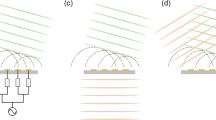Abstract
Millimeter wave (mmWave) communication requires large antenna arrays to increase the capability of cellular networks of the fifth generation with good beam-forming gains and a substantial reduction in path losses for both transmitting and receiving terminals. As large antenna arrays require one radio frequency chain per antenna element, the fully digital beamforming technique results in high cost and high-power consumption, and it is therefore not feasible. However, in analog solutions, adaptive gain control cannot be used as it reduces the likelihood of advanced processing and contributes to poor efficiency. Hybrid schemes are possible exciting solutions that overcome the deficiencies of pure digital or analog beam forming. The following are the three key contributions of the proposed work: a typical link budget specification for target data rate 3.10 Gbps in downlink and 0.6 Gbps in uplink is provided, micro strip patch antenna with a single element is designed to operate at 28 GHz and then converted into a standard linear array and a Kalman-based hybrid analog/digital precoding is used with a downlink rate of 4.64 Gbps/cell and an uplink rate of 1.84 Gbps/cell in multi-user environments. And the influence of both base station (BS) and 5G User equipment (UEs) beam steering capability is also explored. From the simulation result, it is evident that the proposed work offers a substantial increase in spectral efficiency approximately 9.28 bps/Hz at 20 dB with 10 channel paths.


















Similar content being viewed by others
References
5G: A technology vision (2013).
Lopez-Perez, D., Guvenc, I., Roche, G. D. L., Kountouris, M., Quek, T. Q. S., & Zhang, J. (2011). ENHANCED intercell interference coordination challenges in heterogeneous networks. IEEE Wireless Communications, 18(3), 22–30.
Feng, D., Jiang, C., Lim, G., Cimini, L. J., Feng, G., & Li, G. Y. (2013). A survey of energy-effcient wireless communications. IEEE Communications Surveys and Tutorials, 15, 167–178.
Bogale, T. E., & Le, L. B. (2015). Massive MIMO and millimeter wave for 5G wireless HetNet: Potentials and challenges. arXiv preprint https://arxiv.org/abs/1510.06359.
Marzetta, T. L. (2010). Noncooperative cellular wireless with unlimited numbers of base station antennas. IEEE Wireless Communications, 9(11), 3590–3600.
Swindlehurst, A. L., Ayanoglu, E., Heydari, P., & Capolino, F. (2014). Millimeter-wave massive MIMO: The next wireless revolution? IEEE Communications Magazine, 52, 56–62.
Rajagopal, S., Abu-Surra, S., Pi, Z., & Khan, F. (2011). Antenna array design for multi-Gbps mmWave mobile broadband communication. In 2011 IEEE global telecommunications conference-GLOBECOM (pp. 1–6). IEEE.
Huo, Y., Dong, X., & Xu, W. (2017). 5G cellular user equipment: From theory to practical hardware design. IEEE Access, 5, 13992–14010.
El-Ayach, O., Rajagopal, S., Abu-Surra, S., Pi, Z., & Heath, R. W., Jr. (2014). Spatially sparse precoding in millimeter wave MIMO systems. IEEE Transactions on Wireless Communications, 13(3), 1499–1513.
Alkhateeb, A., El-Ayach, O., Leus, G., & Heath, R. W. (2014). Channel estimation and hybrid precoding for millimeter wave cellular systems. IEEE Journal of Selected Topics in Signal Processing, 8(5), 831–846.
Yu, X., Shen, J. C., Zhang, J., & Letaief, K. B. (2016). Alternating minimization algorithms for hybrid precoding in millimeter wave MIMO systems. IEEE Journal of Selected Topics in Signal Processing, 10(3), 485–500.
Sohrabi, F., & Yu, W. (2016). Hybrid digital and analog beamforming design for large-scale antenna arrays. IEEE Journal of Selected Topics in Signal Processing, 10(3), 501–513.
Lin, T., Cong, J., Zhu, Y., Zhang, J., & Letaief, K. B. (2019). Hybrid beamforming for millimeter wave systems using the MMSE criterion. IEEE Transactions on Communications, 67(5), 3693–3708.
Akdeniz, M. R., Liu, Y., Samimi, M. K., Sun, S., Rangan, S., Rappaport, T. S., & Erkip, E. (2014). Millimeter wave channel modeling and cellular capacity evaluation. IEEE Journal on Selected Areas in Communications, 32(6), 1164–1179.
ETSI EN 302 217-4-V2.1 (2017-05)-Fixed radio systems; Characteristics and requirements for point-to-point equipment and antennas; Part 4: Antennas, 2017.
Hemadeh, I. A., Satyanarayana, K., El-Hajjar, M., & Hanzo, L. (2017). Millimeter-wavecommunications: Physical channel models, design considerations, antenna constructions, and link-budget. IEEE Communications Surveys Tutorials, 20(2), 870–913.
Rabinovich, V., & Alexandrov, N. (2013). Antenna arrays and automotive applications. (pp. 24–52). Berlin: Springer.
Das, K. S., & Das, A. (2013). Antenna and wave propagation. (pp. 153–163). New York: Tata McGraw Hill Education Private Limited.
Ni, W., & Dong, X. (2016). Hybrid block diagonalization for massive multiuser MIMO systems. IEEE Transactions on Communications, 64(1), 201–211.
Abdulhameed, M. K., Isa, M. M., Ibrahim, I. M., Mohsin, M. K., Hashim, S. R., & Attiah, M. L. (2018). Improvement of microstrip antenna performance on thick and high permittivity substrate with electromagnetic band gap. Journal of Advanced Research in Dynamical and Control Systems, 10(4), 661–669.
Rappaport, T. S., Heath, R. W., Jr., Daniels, R. C., & Murdock, J. N. (2014). Millimeter wave wireless communications. . Upper Saddle River, NJ: Prentice-Hall.
https://blogs.3ds.com/simulia/5g-antenna-design mobile-phones.
Abou Yassin, M. R., & Abdallah, H. (2020). Hybrid beamforming in multiple user massive multiple input multiple output 5G communications system. In 2020 7th international conference on electrical and electronics engineering (ICEEE) (pp. 215–220). IEEE.
Dai, L., Wang, B., Peng, M., & Chen, S. (2018). Hybrid precoding-based millimeter-wavemassive MIMO-NOMA with simultaneous wireless information and power transfer. IEEE Journal on Selected Areas in Communications, 37(1), 131–141.
Alkhateeb, A., Leus, G., & Heath, R. W. (2015). Limited feedback hybrid precoding for multi-user millimeter wave systems. IEEE Transactions on Wireless Communications, 14(11), 6481–6494.
Vizziello, A., Savazzi, P., & Chowdhury, K. R. (2018). A Kalman based hybrid precoding for multi-user millimeter wave MIMO systems. IEEE Access, 6, 55712–55722.
Author information
Authors and Affiliations
Corresponding author
Additional information
Publisher's Note
Springer Nature remains neutral with regard to jurisdictional claims in published maps and institutional affiliations.
Rights and permissions
About this article
Cite this article
Jeyakumar, P., Malar, E., Idnani, N. et al. Large Antenna Array with Hybrid Beamforming System for 5G Outdoor Mobile Broadband Communication Deployments. Wireless Pers Commun 120, 2001–2027 (2021). https://doi.org/10.1007/s11277-021-08457-5
Accepted:
Published:
Issue Date:
DOI: https://doi.org/10.1007/s11277-021-08457-5




